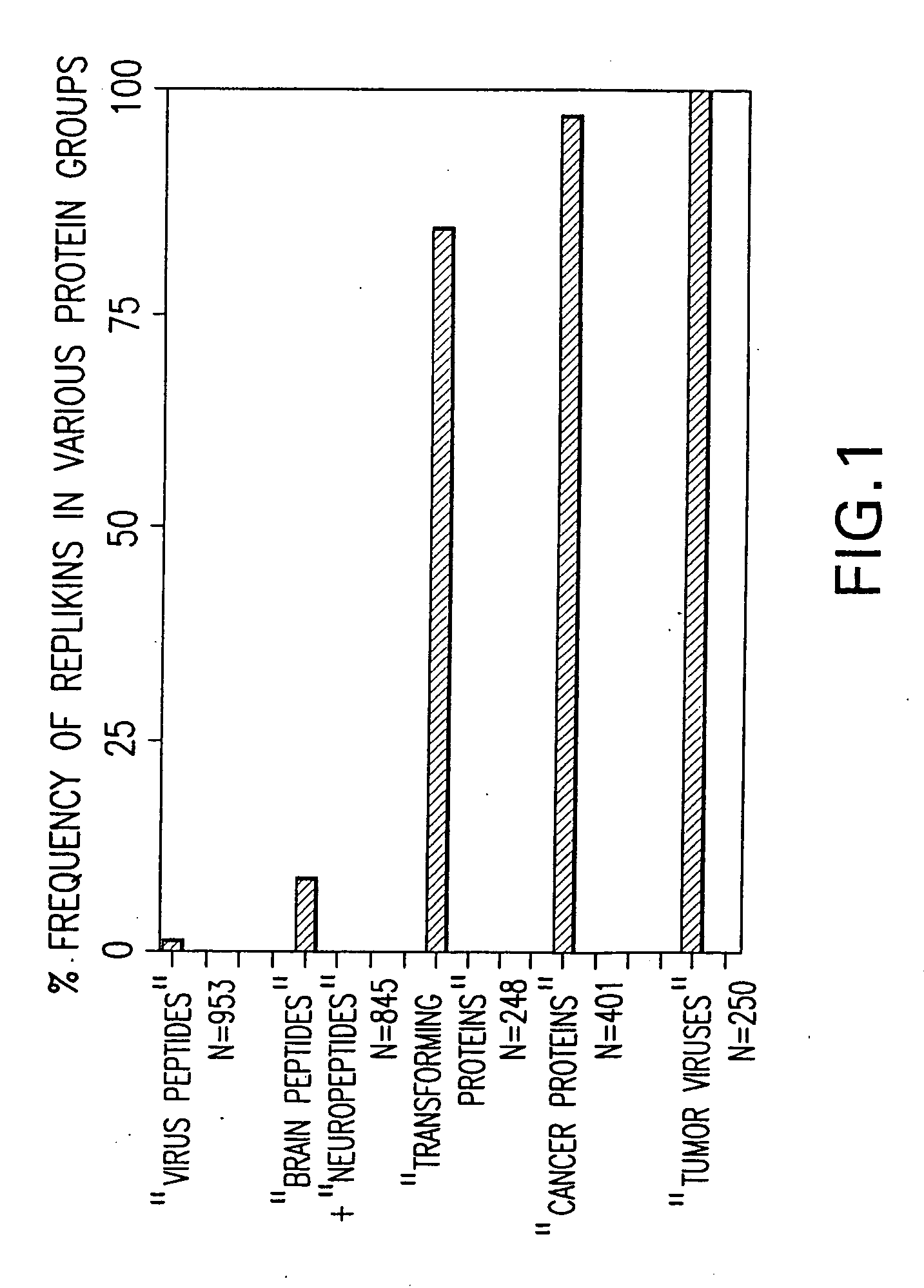Systems and methods for identifying replikin scaffolds and uses of said replikin scaffolds
a technology of replikin and scaffold, which is applied in the field of systems and methods for identifying replikin scaffolds and using said replikin scaffolds, can solve the problems of limited blast tools in terms of the structure of amino acid sequences, and is not capable of searching, and cannot solve the problem of blast being able to search for amino acid sequences
- Summary
- Abstract
- Description
- Claims
- Application Information
AI Technical Summary
Benefits of technology
Problems solved by technology
Method used
Image
Examples
example 1
Process for Extraction, Isolation and Identification of Replikins and the Use of Replikins to Target, Label or Destroy Replikin-Containing Organisms
a) Algae
[0492] The following algae were collected from Bermuda water sites and either extracted on the same day or frozen at −20 degrees C. and extracted the next day. The algae were homogenized in a cold room (at 0 to 5 degrees C) in 1 gram aliquots in neutral buffer, for example 100 cc. of 0.005M phosphate buffer solution, pH 7 (“phosphate buffer”) for 15 minutes in a Waring blender, centrifuged at 3000 rpm, and the supernatant concentrated by perevaporation and dialyzed against phosphate buffer in the cold to produce a volume of approximately 15 ml. The volume of this extract solution was noted and an aliquot taken for protein analysis, and the remainder was fractionated to obtain the protein fraction having a pK range between 1 and 4.
[0493] The preferred method of fractionation is chromatography as follows: The extract solution ...
example 2
[0504] As an example of diagnostic use of Replikins: Aglyco IOB or the 16-mer Replikin may be used as antigen to capture and quantify the amount of its corresponding antibody present in serum for diagnostic purposes are as shown in FIGS. 2, 3, 4 and 7 of U.S. 6,242,578 B1.
[0505] As an example of the production of agents to attach to Replikins for labeling, nutritional or destructive purposes: Injection of the 16-mer Replikin into rabbits to produce the specific antibody to the 16-mer Replikin is shown in Example 6 and FIGS. 9A and 9B of U.S. Pat. No. 6,242,578 B1.
[0506] As an example of the use of agents to label Replikins: The use of antibodies to the 16-mer Replikin to label specific cells which contain this Replikin is shown in FIG. 5 and Example 6 of U.S. Pat. No. 6,242,578 B1.
[0507] As an example of the use of agents to destroy Replikins: The use of antibodies to the 16-mer Replikin to inhibit or destroy specific cells which contain this Replikin is shown in FIG. 6 of U.S. P...
example 3
[0508] Analysis of sequence data of isolates of influenza virus hemagglutinin protein or neuraminidase protein for the presence and concentration of Replikins is carried out by visual scanning of sequences or through use of a computer program based on the 3-point recognition system described herein. Isolates of influenza virus are obtained and the amino acid sequence of the influenza hemagglutinin and / or neuraminidase protein is obtained by any art known method, such as by sequencing the hemagglutinin or neuraminidase gene and deriving the protein sequence therefrom. Sequences are scanned for the presence of new Replikins, conservation of Replikins over time and concentration of Replikins in each isolate. Comparison of the Replikin sequences and concentrations to the amino acid sequences obtained from isolates at an earlier time, such as about six months to about three years earlier, provides data that are used to predict the emergence of strains that are most likely to be the cause...
PUM
| Property | Measurement | Unit |
|---|---|---|
| Fraction | aaaaa | aaaaa |
| Mass | aaaaa | aaaaa |
| Time | aaaaa | aaaaa |
Abstract
Description
Claims
Application Information
 Login to View More
Login to View More - R&D
- Intellectual Property
- Life Sciences
- Materials
- Tech Scout
- Unparalleled Data Quality
- Higher Quality Content
- 60% Fewer Hallucinations
Browse by: Latest US Patents, China's latest patents, Technical Efficacy Thesaurus, Application Domain, Technology Topic, Popular Technical Reports.
© 2025 PatSnap. All rights reserved.Legal|Privacy policy|Modern Slavery Act Transparency Statement|Sitemap|About US| Contact US: help@patsnap.com



